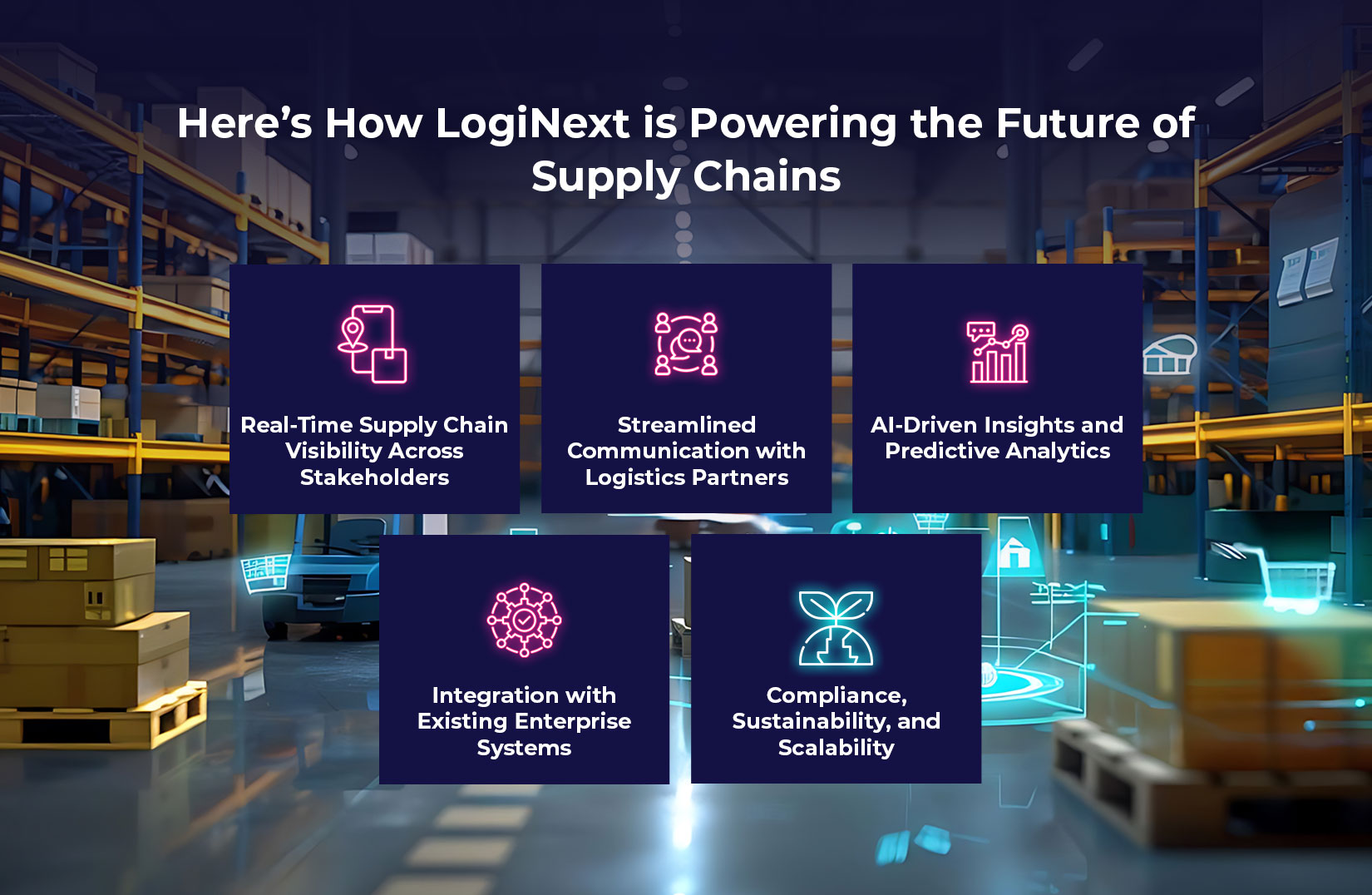
5 Ways LogiNext’s Tech Collaboration Drives Supply Chain Innovation
In today’s hyper-connected world, supply chain management has evolved beyond simple inventory tracking and logistics. It now involves real-time visibility, data-driven decisions, and seamless collaboration across partners. With global supply chains facing increasing complexity and pressure to deliver more efficiently, companies are turning to advanced logistics technologies to stay competitive.
Modernizing supply chains is greatly assisted by LogiNext, a pioneer in logistics optimization and transportation automation. By enabling smart collaboration across systems and stakeholders, LogiNext’s technology is driving significant transformation in how businesses manage their end-to-end operations.
Here’s How LogiNext is Powering the Future of Supply Chains

1. Real-Time Supply Chain Visibility Across Stakeholders:
One of the most pressing challenges in logistics is the lack of visibility across the entire supply chain. According to a McKinsey report, 70% of supply chain executives reported not having full visibility into their operations. LogiNext addresses this with its cutting-edge supply chain visibility software, offering live tracking of shipments, drivers, and inventory at every touchpoint.
What makes LogiNext’s platform unique is its ability to integrate multiple data sources—GPS, IoT sensors, and ERP systems—into a unified dashboard. This collaborative infrastructure ensures that manufacturers, distributors, retailers, and customers have access to consistent and up-to-date information.
As a result, businesses can:
– Reduce delays with predictive alerts
– Make proactive decisions during disruptions
– Increase transparency for end customers
This level of visibility not only improves operational efficiency but also builds trust across the ecosystem.
2. Streamlined Communication with Logistics Partners:
Traditional logistics depends excessively on emails, phone calls, and manual coordination. This approach leads to communication breakdowns, especially in multi-tiered supply chains. LogiNext resolves this with built-in collaboration tools that foster seamless interaction among all stakeholders. In fact, a Capgemini study found that over 60% of supply chain issues stem from poor communication between partners.
The platform enables shippers, logistics companies, and independent vendors to:
– Share real-time delivery updates
– Automate scheduling and dispatching
– Manage exceptions collaboratively
This collaborative supply chain management system eliminates silos and accelerates response times. For example, when a route disruption occurs, all parties can instantly coordinate rerouting via the LogiNext platform, avoiding delays and penalties.
Improved communication translates into faster turnaround times and fewer errors, making supply chains more agile and responsive.
3. AI-Driven Insights and Predictive Analytics:
Every day, modern supply chains produce enormous volumes of data. Converting such data into useful insights is the difficult part. LogiNext uses AI and machine learning to analyze trends, identify bottlenecks, and predict future risks.
Key Features of LogiNext’s AI capabilities include:
– Delivery ETA predictions with over 90% accuracy
– Forecasting of demand and delivery load by region
– Analysis of driver performance and route efficiency
These insights empower supply chain leaders to make better strategic decisions. For instance, predictive analytics can warn businesses about potential delivery failures due to bad weather or traffic congestion. Thereby, allowing them to take corrective actions ahead of time. According to Supply Chain Quarterly, predictive analytics can cut supply chain costs by 10-15% and improve service levels by up to 35%.
4. Integration with Existing Enterprise Systems:
Supply chains today rely on various digital systems- TMS, WMS, CRM, and ERP platforms. One of LogiNext’s strengths lies in its ability to integrate smoothly with these systems. This provides a truly connected supply chain management software experience. A Forrester report found that 67% of companies struggle with integrating supply chain applications across departments.
Through APIs and plug-and-play modules, LogiNext bridges the gap between logistics operations and enterprise platforms. This integration brings all relevant data onto a single interface, enabling:
– Unified reporting and analytics
– Faster onboarding of logistics partners
– Automated workflows from order to delivery
Such collaboration ensures that all departments- sales, operations, procurement, and customer service- are aligned with real-time logistics updates. This alignment improves overall efficiency and helps in creating a holistic customer experience.
5. Compliance, Sustainability and Scalability:
In a globalized world, supply chains must comply with regional regulations and sustainability standards. A 2024 Accenture study shows that 75% of executives consider sustainability a top-three business priority. LogiNext’s logistics collaboration tools help businesses monitor compliance metrics in real time and align with global best practices.
With features like:
– Geo-fencing for compliance tracking
– Electronic proof of delivery (ePOD)
– Emissions reporting and route optimization
LogiNext helps organizations reduce carbon emissions and improve delivery compliance. According to Gartner, 60% of companies are planning to invest in supply chain sustainability tools in the next two years. LogiNext is well-positioned to lead this shift.
Moreover, its platform is designed to scale. Whether you’re managing 1,000 deliveries or 100,000, LogiNext’s architecture can handle increasing volumes without compromising on speed or accuracy.
This scalability is especially crucial for businesses aiming to expand into new markets or rapidly onboard logistics partners.
Conclusion: Building the Future of Supply Chain Collaboration
Innovation in the supply chain involves more than just implementing new technologies. It also involves rethinking how various organizations collaborate. LogiNext’s logistics technology doesn’t operate in isolation. It creates an intelligent, collaborative, and data-driven environment that fosters transparency, speed, and control.
By enabling real-time visibility, seamless communication, AI-powered insights, system integration, and scalable infrastructure, LogiNext transforms traditional logistics into a modern supply chain management powerhouse.
If you’re looking to enhance your operations with robust supply chain visibility, reduce costs, and stay ahead of the curve, embracing LogiNext’s collaborative logistics platform could be your smartest move. So, click on the red button below and book a demo with LogiNext today.
45







@LogiNext